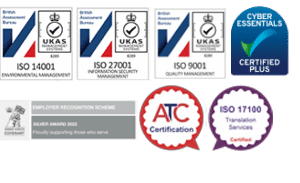Video conference interpreting bridges the language gap between participants in a video conference. It allows participants to communicate effectively with one another, making sure everyone understands what is being said.
There has been a growing adoption and improvement of video conference technology and increasing globalisation of the marketplace. This means the need for remote video interpreting services for language or BSL is growing significantly.
Discover how the process works, the equipment you will need and the main benefits of video conference interpreting.
Remote video interpreting
The remote video interpreting process is pretty straightforward. The remote interpreter will join your video call along with all other participants and provide a live interpreting service. Alternatively, remote video interpreters can also be used in face-to-face meetings, too. They’ll provide the translation virtually via video call, whilst all other participants are in the same room.
It is important interpreters can see and hear all other participants on the call, as gestures and non-verbal signs, as well as the speech itself, can help improve the accuracy and quality of the translation.
There are two main types of video conference interpreting available:
- Language interpreting
- BSL interpreting for participants who are deaf or hard of hearing
For language interpretations, the video conference interpreter will provide a live translation of everyone’s speech, which can be sent to an individual or distributed among participants. On video conferences with multiple languages involved, this process is repeated for each language pairing – so if there are three languages being spoken on the call, then you would have two interpreters working at once.
Alternatively, for BSL video interpreting, interpreters will provide a live sign language interpreting of the video conference.
What equipment do I need for video conference interpreting?
Video conference interpreting requires the same equipment you would use for any normal video conference. All you need is access to video conferencing software, a microphone, headphones or speakers and a camera. At DA Languages we use our own video interpreting software and a native app that will connect you to a live feed where you can speak with your chosen interpreter.
Although no extra special or technical equipment is needed, there are considerations to take into account for getting the best translation possible:
- A fast and stable internet connection. This ensures the meeting runs smoothly and doesn’t end due to a participant losing connection. It also helps the interpreter avoid missing anything being said due to lag or participants dropping out of the call.
- A high-quality microphone. It is important that the interpreter can clearly hear and understand participants when they are speaking for maximum accuracy.
- A high-quality camera. Although not strictly necessary, a good quality camera can improve the accuracy and quality of the translation. A camera that shows the interpreter a clear image means they can pick up visual cues, facial expressions and gestures. This can improve the quality of their translation.
How much does video conference interpreting cost?
With no extra investment in equipment or travel expenses needed, remote video interpreting is a cost-effective option.
The price of in-person interpreting can vary due to factors such as qualification level and location. However, on the whole, video conference interpreting costs tend to be much lower than face-to-face interpreting due to having fewer overheads.
So what does this all mean for you and your business? You can make the most of the following advantages when you work with a DA Languages video interpreter.
- Greater flexibility and access to more interpreters: Video conferencing allows interpreters to work from home or any other location. This means you won’t have to wait for them to travel to you and calls can be set up anywhere at any time. You’ll also gain access to a larger pool of interpreters, which is especially useful for rare languages and dialects.
- More cost-effective: Video conference interpreting can be a more affordable option than face-to-face interpreting, especially if the meeting involves multiple languages and participants from across different time zones.
- Greater accuracy: Video conference interpreters have access to visual cues that they wouldn’t get in normal interpreting situations with other participants. This can help them to provide more accurate and precise interpreting when compared to audio-only interpreting.
- On-demand video interpreting: Our video interpreting services are accessible on-demand via the DA Languages app, so you can easily get access an interpreter on short notice.
How DA Languages can help
We can provide you with a qualified, experienced video interpreter that meets your unique requirements. When using our video conference interpreting services, you will be able to instantly connect to the interpreter you need, or you can book one for a future meeting. We also offer client training for the best practices to follow when using our service.
If you want to find out more about video conference interpreting or how we can support you and your interpreting needs, don’t hesitate to get in touch!



